PCR: Overview, Applications in Forensics - Molecular Biology 300817
VerifiedAdded on 2023/06/08
|9
|2264
|273
Report
AI Summary
This report provides a comprehensive overview of the Polymerase Chain Reaction (PCR), a fundamental technique in molecular biology. It details the history of PCR, its basic principles, and the essential components required for the reaction, including template DNA, DNA polymerase, primers, and dNTPs. The report outlines the key steps of PCR: initialization, denaturation, annealing, and elongation, explaining the temperature and time parameters for each step. Furthermore, it explores the application of PCR in forensic investigations, specifically in DNA profiling using Variable Number Tandem Repeats (VNTRs) and Short Tandem Repeats (STRs). The report concludes by highlighting the significant impact of PCR technology on various fields involving DNA research and its advantages over traditional methods.
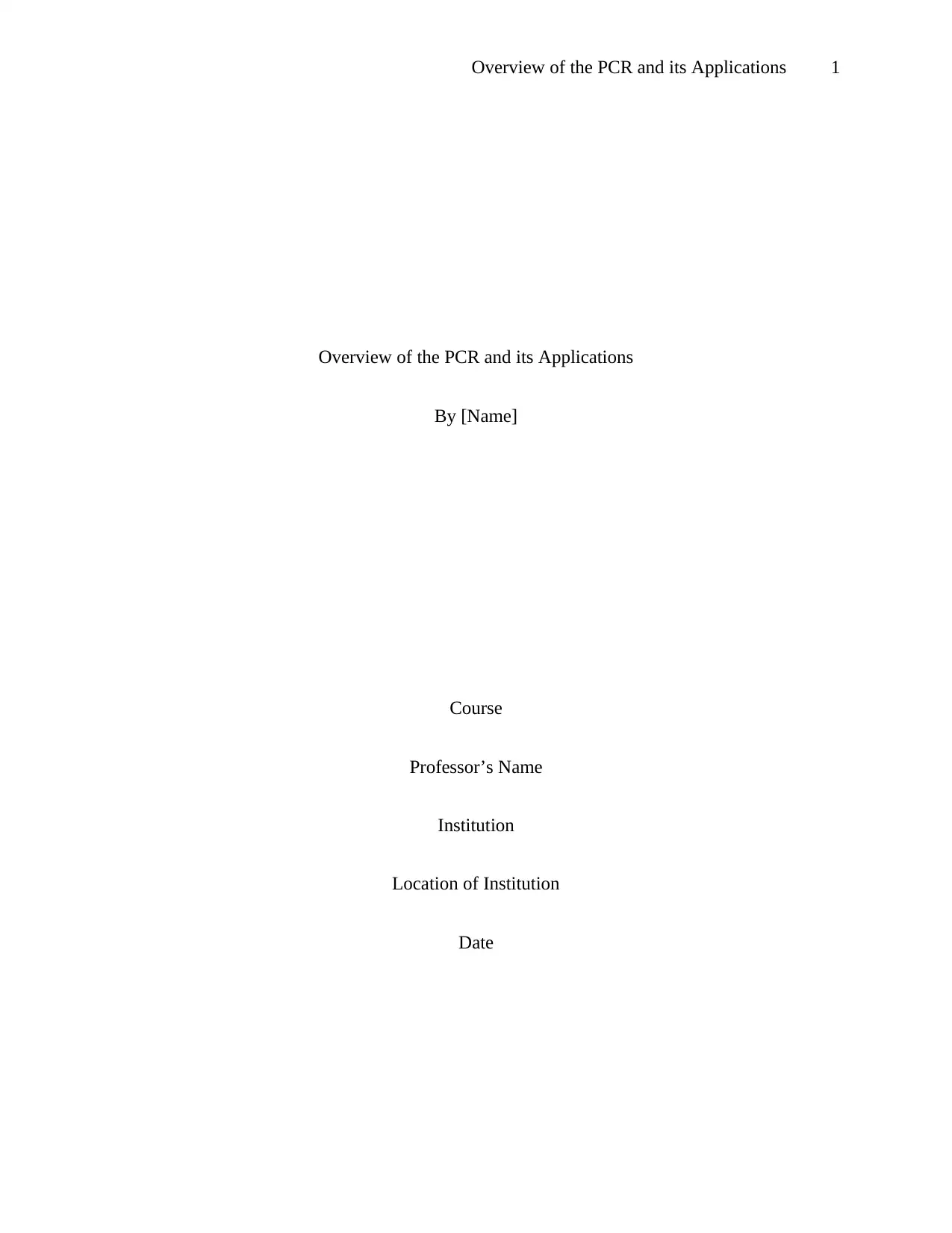
Overview of the PCR and its Applications 1
Overview of the PCR and its Applications
By [Name]
Course
Professor’s Name
Institution
Location of Institution
Date
Overview of the PCR and its Applications
By [Name]
Course
Professor’s Name
Institution
Location of Institution
Date
Paraphrase This Document
Need a fresh take? Get an instant paraphrase of this document with our AI Paraphraser
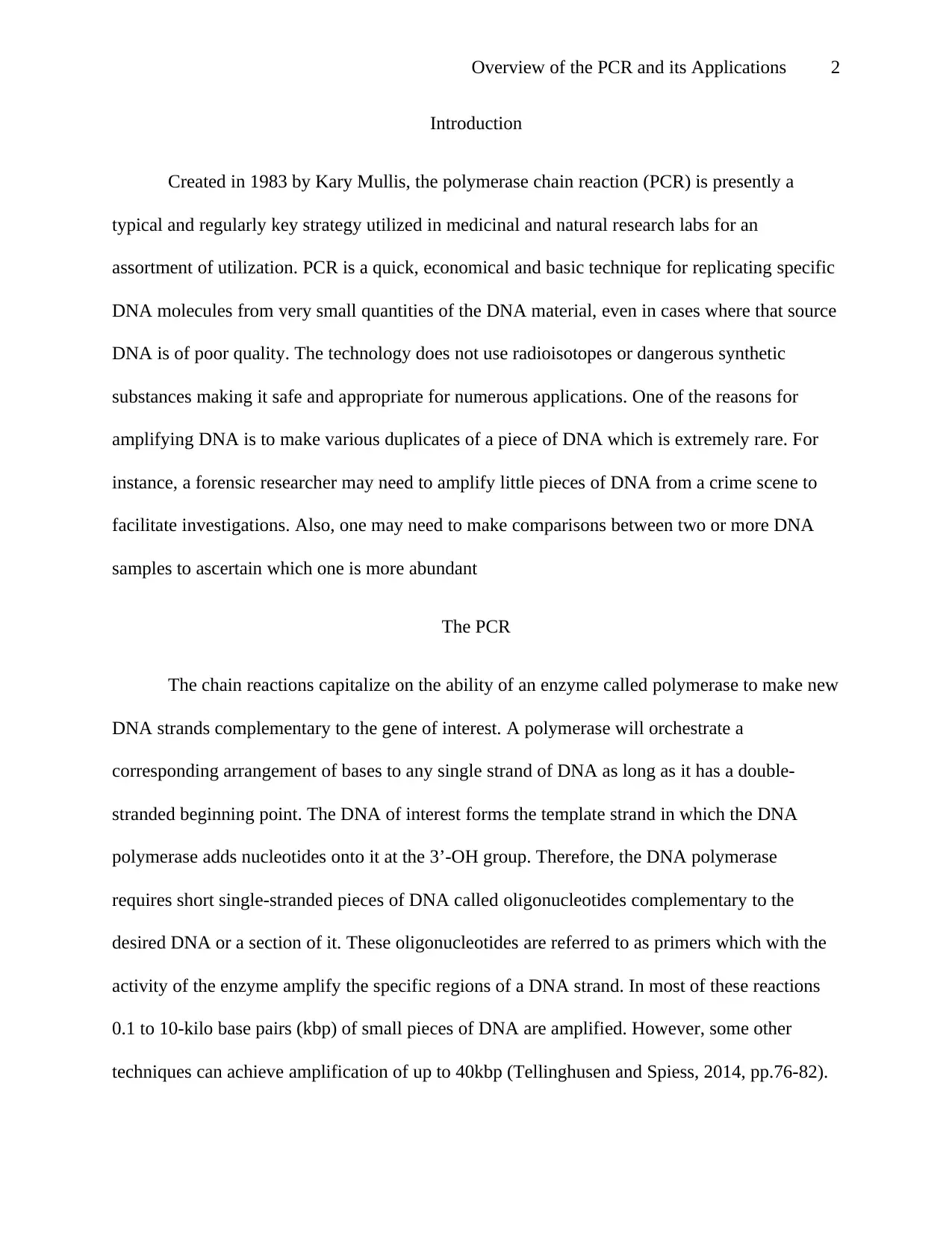
Overview of the PCR and its Applications 2
Introduction
Created in 1983 by Kary Mullis, the polymerase chain reaction (PCR) is presently a
typical and regularly key strategy utilized in medicinal and natural research labs for an
assortment of utilization. PCR is a quick, economical and basic technique for replicating specific
DNA molecules from very small quantities of the DNA material, even in cases where that source
DNA is of poor quality. The technology does not use radioisotopes or dangerous synthetic
substances making it safe and appropriate for numerous applications. One of the reasons for
amplifying DNA is to make various duplicates of a piece of DNA which is extremely rare. For
instance, a forensic researcher may need to amplify little pieces of DNA from a crime scene to
facilitate investigations. Also, one may need to make comparisons between two or more DNA
samples to ascertain which one is more abundant
The PCR
The chain reactions capitalize on the ability of an enzyme called polymerase to make new
DNA strands complementary to the gene of interest. A polymerase will orchestrate a
corresponding arrangement of bases to any single strand of DNA as long as it has a double-
stranded beginning point. The DNA of interest forms the template strand in which the DNA
polymerase adds nucleotides onto it at the 3’-OH group. Therefore, the DNA polymerase
requires short single-stranded pieces of DNA called oligonucleotides complementary to the
desired DNA or a section of it. These oligonucleotides are referred to as primers which with the
activity of the enzyme amplify the specific regions of a DNA strand. In most of these reactions
0.1 to 10-kilo base pairs (kbp) of small pieces of DNA are amplified. However, some other
techniques can achieve amplification of up to 40kbp (Tellinghusen and Spiess, 2014, pp.76-82).
Introduction
Created in 1983 by Kary Mullis, the polymerase chain reaction (PCR) is presently a
typical and regularly key strategy utilized in medicinal and natural research labs for an
assortment of utilization. PCR is a quick, economical and basic technique for replicating specific
DNA molecules from very small quantities of the DNA material, even in cases where that source
DNA is of poor quality. The technology does not use radioisotopes or dangerous synthetic
substances making it safe and appropriate for numerous applications. One of the reasons for
amplifying DNA is to make various duplicates of a piece of DNA which is extremely rare. For
instance, a forensic researcher may need to amplify little pieces of DNA from a crime scene to
facilitate investigations. Also, one may need to make comparisons between two or more DNA
samples to ascertain which one is more abundant
The PCR
The chain reactions capitalize on the ability of an enzyme called polymerase to make new
DNA strands complementary to the gene of interest. A polymerase will orchestrate a
corresponding arrangement of bases to any single strand of DNA as long as it has a double-
stranded beginning point. The DNA of interest forms the template strand in which the DNA
polymerase adds nucleotides onto it at the 3’-OH group. Therefore, the DNA polymerase
requires short single-stranded pieces of DNA called oligonucleotides complementary to the
desired DNA or a section of it. These oligonucleotides are referred to as primers which with the
activity of the enzyme amplify the specific regions of a DNA strand. In most of these reactions
0.1 to 10-kilo base pairs (kbp) of small pieces of DNA are amplified. However, some other
techniques can achieve amplification of up to 40kbp (Tellinghusen and Spiess, 2014, pp.76-82).
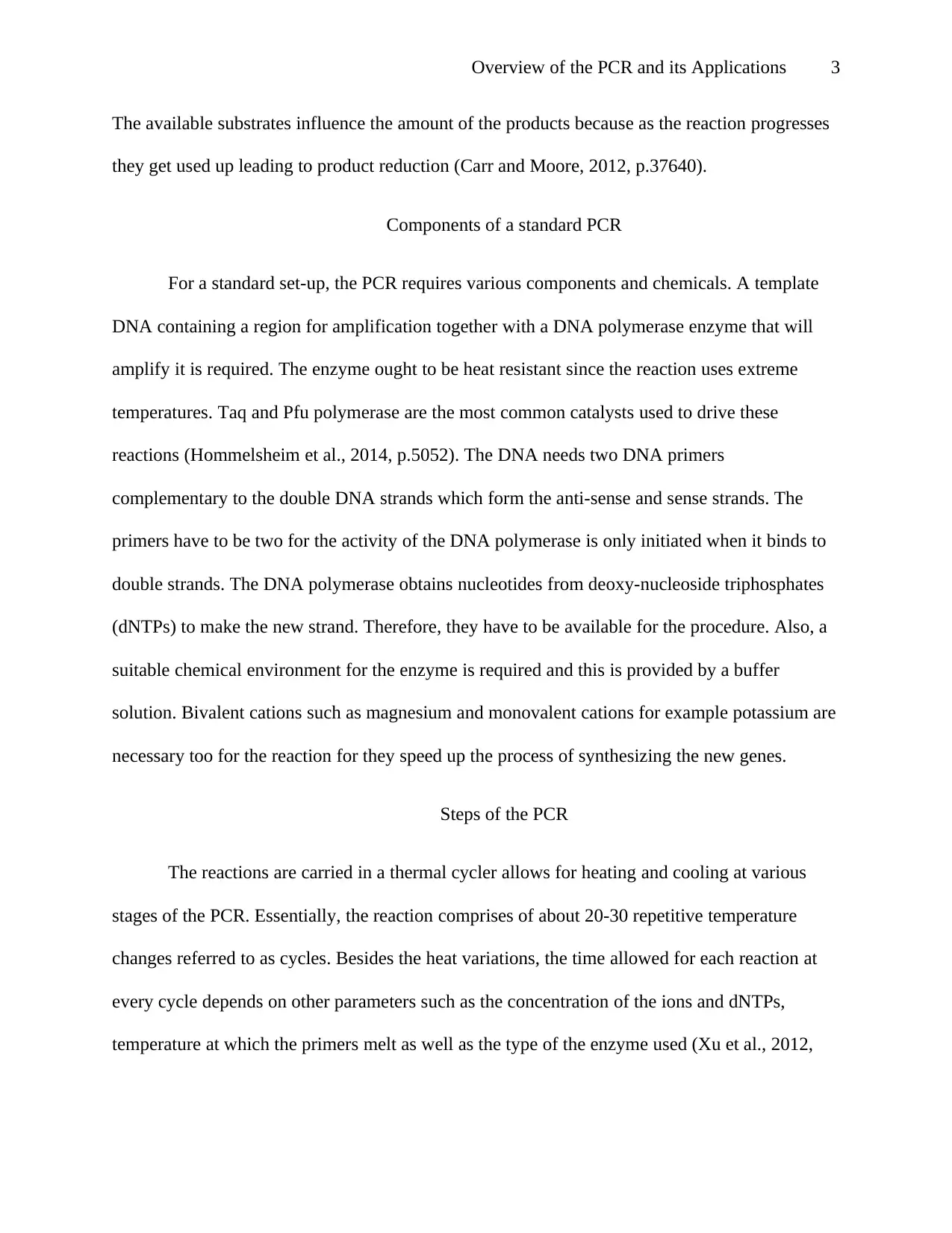
Overview of the PCR and its Applications 3
The available substrates influence the amount of the products because as the reaction progresses
they get used up leading to product reduction (Carr and Moore, 2012, p.37640).
Components of a standard PCR
For a standard set-up, the PCR requires various components and chemicals. A template
DNA containing a region for amplification together with a DNA polymerase enzyme that will
amplify it is required. The enzyme ought to be heat resistant since the reaction uses extreme
temperatures. Taq and Pfu polymerase are the most common catalysts used to drive these
reactions (Hommelsheim et al., 2014, p.5052). The DNA needs two DNA primers
complementary to the double DNA strands which form the anti-sense and sense strands. The
primers have to be two for the activity of the DNA polymerase is only initiated when it binds to
double strands. The DNA polymerase obtains nucleotides from deoxy-nucleoside triphosphates
(dNTPs) to make the new strand. Therefore, they have to be available for the procedure. Also, a
suitable chemical environment for the enzyme is required and this is provided by a buffer
solution. Bivalent cations such as magnesium and monovalent cations for example potassium are
necessary too for the reaction for they speed up the process of synthesizing the new genes.
Steps of the PCR
The reactions are carried in a thermal cycler allows for heating and cooling at various
stages of the PCR. Essentially, the reaction comprises of about 20-30 repetitive temperature
changes referred to as cycles. Besides the heat variations, the time allowed for each reaction at
every cycle depends on other parameters such as the concentration of the ions and dNTPs,
temperature at which the primers melt as well as the type of the enzyme used (Xu et al., 2012,
The available substrates influence the amount of the products because as the reaction progresses
they get used up leading to product reduction (Carr and Moore, 2012, p.37640).
Components of a standard PCR
For a standard set-up, the PCR requires various components and chemicals. A template
DNA containing a region for amplification together with a DNA polymerase enzyme that will
amplify it is required. The enzyme ought to be heat resistant since the reaction uses extreme
temperatures. Taq and Pfu polymerase are the most common catalysts used to drive these
reactions (Hommelsheim et al., 2014, p.5052). The DNA needs two DNA primers
complementary to the double DNA strands which form the anti-sense and sense strands. The
primers have to be two for the activity of the DNA polymerase is only initiated when it binds to
double strands. The DNA polymerase obtains nucleotides from deoxy-nucleoside triphosphates
(dNTPs) to make the new strand. Therefore, they have to be available for the procedure. Also, a
suitable chemical environment for the enzyme is required and this is provided by a buffer
solution. Bivalent cations such as magnesium and monovalent cations for example potassium are
necessary too for the reaction for they speed up the process of synthesizing the new genes.
Steps of the PCR
The reactions are carried in a thermal cycler allows for heating and cooling at various
stages of the PCR. Essentially, the reaction comprises of about 20-30 repetitive temperature
changes referred to as cycles. Besides the heat variations, the time allowed for each reaction at
every cycle depends on other parameters such as the concentration of the ions and dNTPs,
temperature at which the primers melt as well as the type of the enzyme used (Xu et al., 2012,
⊘ This is a preview!⊘
Do you want full access?
Subscribe today to unlock all pages.

Trusted by 1+ million students worldwide
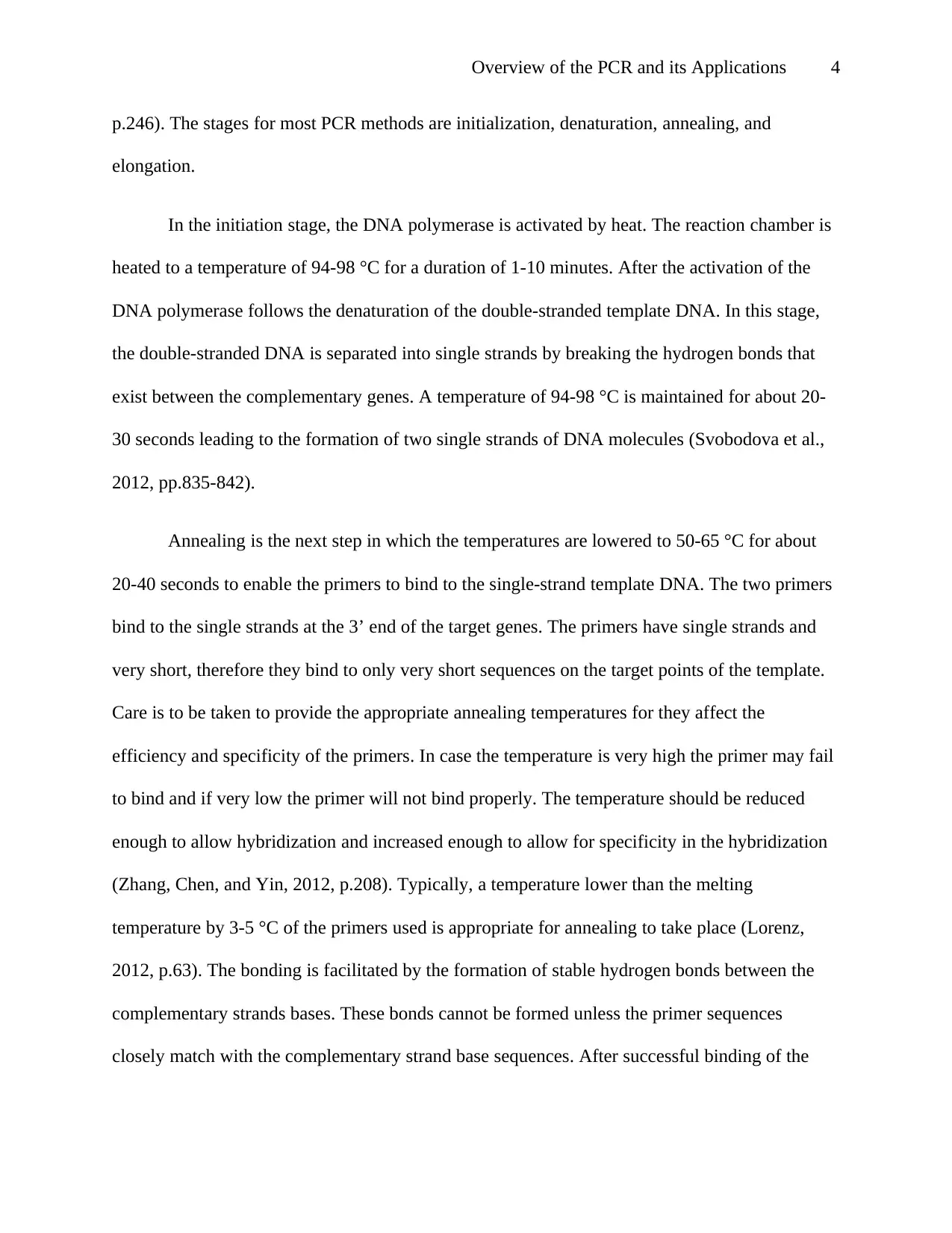
Overview of the PCR and its Applications 4
p.246). The stages for most PCR methods are initialization, denaturation, annealing, and
elongation.
In the initiation stage, the DNA polymerase is activated by heat. The reaction chamber is
heated to a temperature of 94-98 °C for a duration of 1-10 minutes. After the activation of the
DNA polymerase follows the denaturation of the double-stranded template DNA. In this stage,
the double-stranded DNA is separated into single strands by breaking the hydrogen bonds that
exist between the complementary genes. A temperature of 94-98 °C is maintained for about 20-
30 seconds leading to the formation of two single strands of DNA molecules (Svobodova et al.,
2012, pp.835-842).
Annealing is the next step in which the temperatures are lowered to 50-65 °C for about
20-40 seconds to enable the primers to bind to the single-strand template DNA. The two primers
bind to the single strands at the 3’ end of the target genes. The primers have single strands and
very short, therefore they bind to only very short sequences on the target points of the template.
Care is to be taken to provide the appropriate annealing temperatures for they affect the
efficiency and specificity of the primers. In case the temperature is very high the primer may fail
to bind and if very low the primer will not bind properly. The temperature should be reduced
enough to allow hybridization and increased enough to allow for specificity in the hybridization
(Zhang, Chen, and Yin, 2012, p.208). Typically, a temperature lower than the melting
temperature by 3-5 °C of the primers used is appropriate for annealing to take place (Lorenz,
2012, p.63). The bonding is facilitated by the formation of stable hydrogen bonds between the
complementary strands bases. These bonds cannot be formed unless the primer sequences
closely match with the complementary strand base sequences. After successful binding of the
p.246). The stages for most PCR methods are initialization, denaturation, annealing, and
elongation.
In the initiation stage, the DNA polymerase is activated by heat. The reaction chamber is
heated to a temperature of 94-98 °C for a duration of 1-10 minutes. After the activation of the
DNA polymerase follows the denaturation of the double-stranded template DNA. In this stage,
the double-stranded DNA is separated into single strands by breaking the hydrogen bonds that
exist between the complementary genes. A temperature of 94-98 °C is maintained for about 20-
30 seconds leading to the formation of two single strands of DNA molecules (Svobodova et al.,
2012, pp.835-842).
Annealing is the next step in which the temperatures are lowered to 50-65 °C for about
20-40 seconds to enable the primers to bind to the single-strand template DNA. The two primers
bind to the single strands at the 3’ end of the target genes. The primers have single strands and
very short, therefore they bind to only very short sequences on the target points of the template.
Care is to be taken to provide the appropriate annealing temperatures for they affect the
efficiency and specificity of the primers. In case the temperature is very high the primer may fail
to bind and if very low the primer will not bind properly. The temperature should be reduced
enough to allow hybridization and increased enough to allow for specificity in the hybridization
(Zhang, Chen, and Yin, 2012, p.208). Typically, a temperature lower than the melting
temperature by 3-5 °C of the primers used is appropriate for annealing to take place (Lorenz,
2012, p.63). The bonding is facilitated by the formation of stable hydrogen bonds between the
complementary strands bases. These bonds cannot be formed unless the primer sequences
closely match with the complementary strand base sequences. After successful binding of the
Paraphrase This Document
Need a fresh take? Get an instant paraphrase of this document with our AI Paraphraser
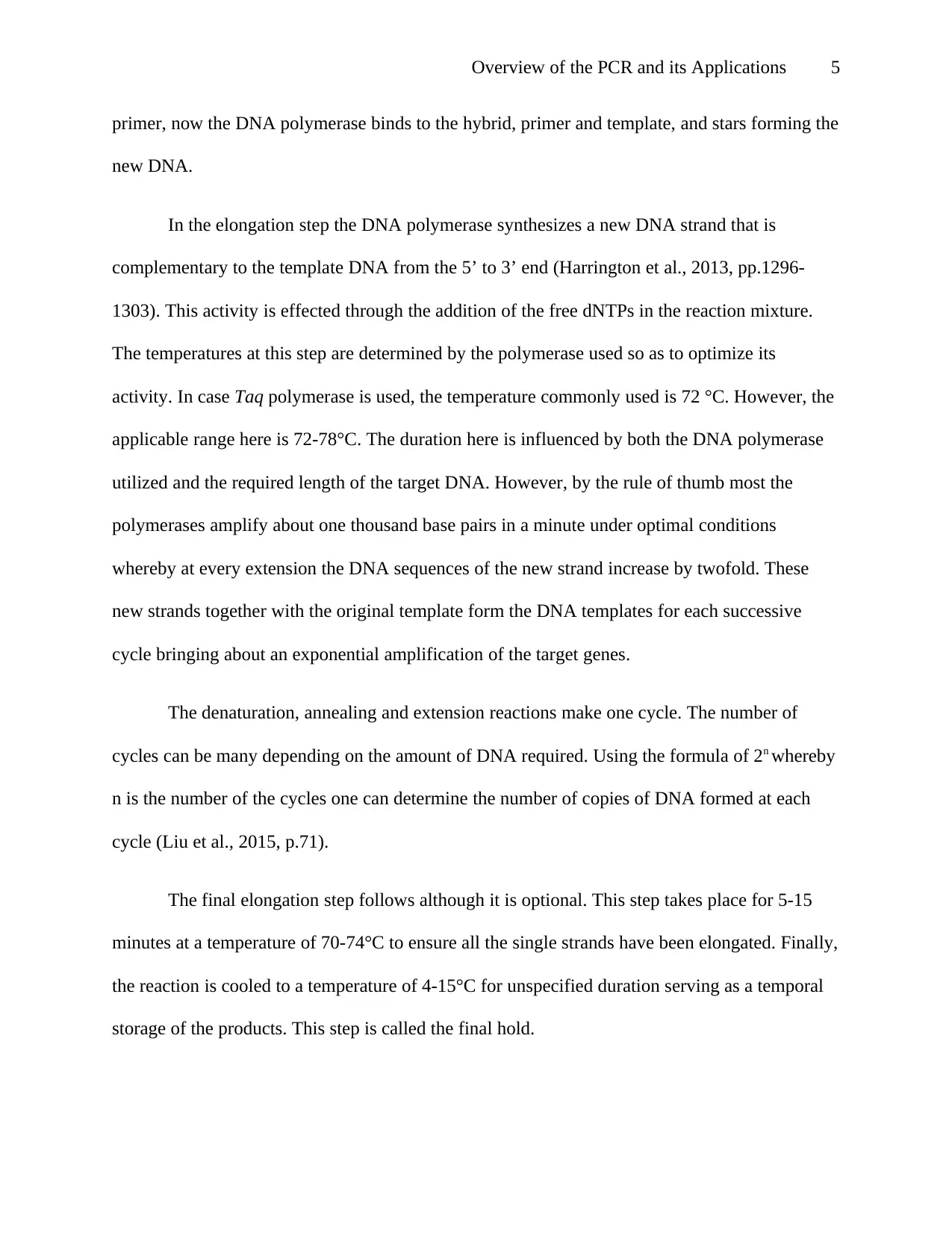
Overview of the PCR and its Applications 5
primer, now the DNA polymerase binds to the hybrid, primer and template, and stars forming the
new DNA.
In the elongation step the DNA polymerase synthesizes a new DNA strand that is
complementary to the template DNA from the 5’ to 3’ end (Harrington et al., 2013, pp.1296-
1303). This activity is effected through the addition of the free dNTPs in the reaction mixture.
The temperatures at this step are determined by the polymerase used so as to optimize its
activity. In case Taq polymerase is used, the temperature commonly used is 72 °C. However, the
applicable range here is 72-78°C. The duration here is influenced by both the DNA polymerase
utilized and the required length of the target DNA. However, by the rule of thumb most the
polymerases amplify about one thousand base pairs in a minute under optimal conditions
whereby at every extension the DNA sequences of the new strand increase by twofold. These
new strands together with the original template form the DNA templates for each successive
cycle bringing about an exponential amplification of the target genes.
The denaturation, annealing and extension reactions make one cycle. The number of
cycles can be many depending on the amount of DNA required. Using the formula of 2n whereby
n is the number of the cycles one can determine the number of copies of DNA formed at each
cycle (Liu et al., 2015, p.71).
The final elongation step follows although it is optional. This step takes place for 5-15
minutes at a temperature of 70-74°C to ensure all the single strands have been elongated. Finally,
the reaction is cooled to a temperature of 4-15°C for unspecified duration serving as a temporal
storage of the products. This step is called the final hold.
primer, now the DNA polymerase binds to the hybrid, primer and template, and stars forming the
new DNA.
In the elongation step the DNA polymerase synthesizes a new DNA strand that is
complementary to the template DNA from the 5’ to 3’ end (Harrington et al., 2013, pp.1296-
1303). This activity is effected through the addition of the free dNTPs in the reaction mixture.
The temperatures at this step are determined by the polymerase used so as to optimize its
activity. In case Taq polymerase is used, the temperature commonly used is 72 °C. However, the
applicable range here is 72-78°C. The duration here is influenced by both the DNA polymerase
utilized and the required length of the target DNA. However, by the rule of thumb most the
polymerases amplify about one thousand base pairs in a minute under optimal conditions
whereby at every extension the DNA sequences of the new strand increase by twofold. These
new strands together with the original template form the DNA templates for each successive
cycle bringing about an exponential amplification of the target genes.
The denaturation, annealing and extension reactions make one cycle. The number of
cycles can be many depending on the amount of DNA required. Using the formula of 2n whereby
n is the number of the cycles one can determine the number of copies of DNA formed at each
cycle (Liu et al., 2015, p.71).
The final elongation step follows although it is optional. This step takes place for 5-15
minutes at a temperature of 70-74°C to ensure all the single strands have been elongated. Finally,
the reaction is cooled to a temperature of 4-15°C for unspecified duration serving as a temporal
storage of the products. This step is called the final hold.
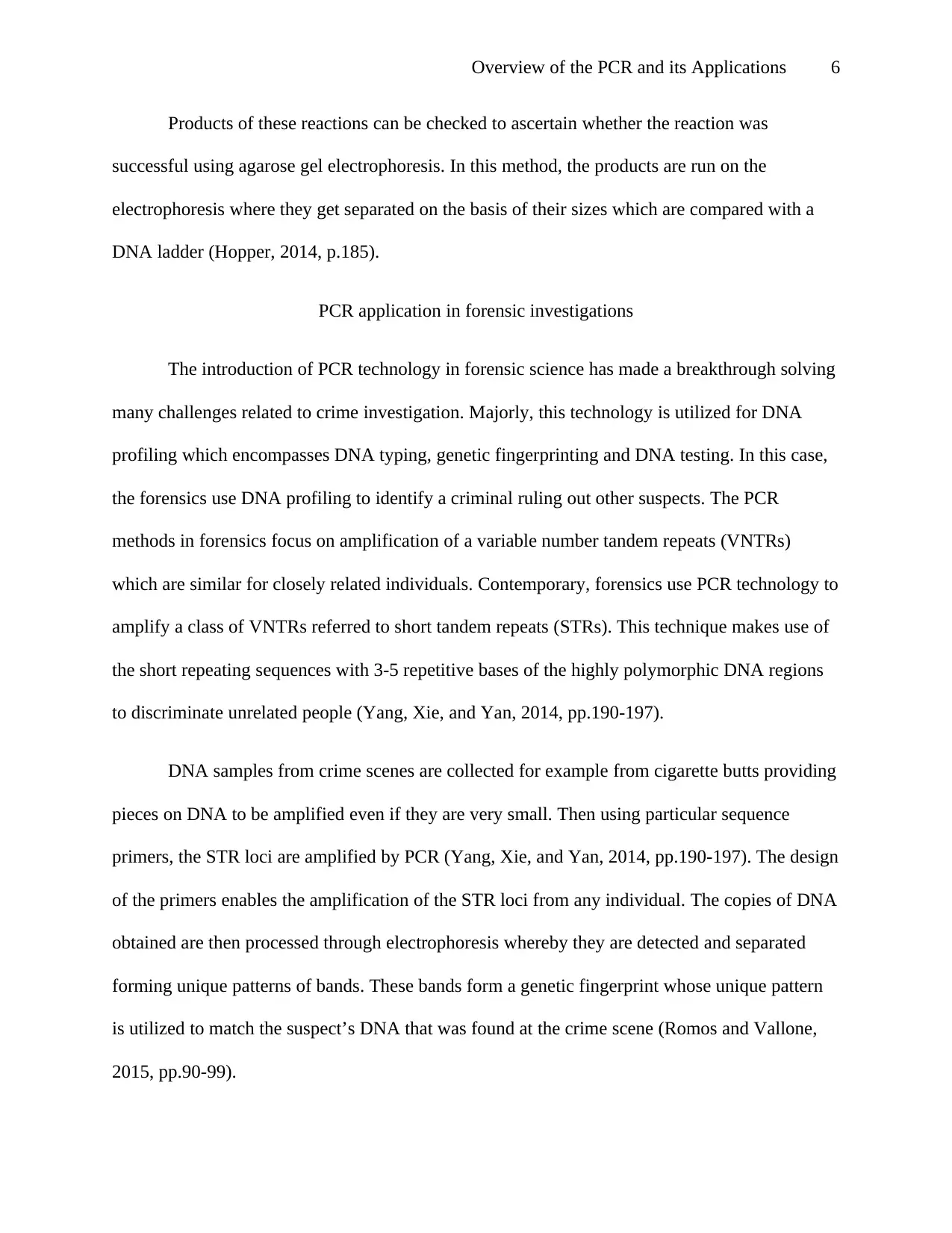
Overview of the PCR and its Applications 6
Products of these reactions can be checked to ascertain whether the reaction was
successful using agarose gel electrophoresis. In this method, the products are run on the
electrophoresis where they get separated on the basis of their sizes which are compared with a
DNA ladder (Hopper, 2014, p.185).
PCR application in forensic investigations
The introduction of PCR technology in forensic science has made a breakthrough solving
many challenges related to crime investigation. Majorly, this technology is utilized for DNA
profiling which encompasses DNA typing, genetic fingerprinting and DNA testing. In this case,
the forensics use DNA profiling to identify a criminal ruling out other suspects. The PCR
methods in forensics focus on amplification of a variable number tandem repeats (VNTRs)
which are similar for closely related individuals. Contemporary, forensics use PCR technology to
amplify a class of VNTRs referred to short tandem repeats (STRs). This technique makes use of
the short repeating sequences with 3-5 repetitive bases of the highly polymorphic DNA regions
to discriminate unrelated people (Yang, Xie, and Yan, 2014, pp.190-197).
DNA samples from crime scenes are collected for example from cigarette butts providing
pieces on DNA to be amplified even if they are very small. Then using particular sequence
primers, the STR loci are amplified by PCR (Yang, Xie, and Yan, 2014, pp.190-197). The design
of the primers enables the amplification of the STR loci from any individual. The copies of DNA
obtained are then processed through electrophoresis whereby they are detected and separated
forming unique patterns of bands. These bands form a genetic fingerprint whose unique pattern
is utilized to match the suspect’s DNA that was found at the crime scene (Romos and Vallone,
2015, pp.90-99).
Products of these reactions can be checked to ascertain whether the reaction was
successful using agarose gel electrophoresis. In this method, the products are run on the
electrophoresis where they get separated on the basis of their sizes which are compared with a
DNA ladder (Hopper, 2014, p.185).
PCR application in forensic investigations
The introduction of PCR technology in forensic science has made a breakthrough solving
many challenges related to crime investigation. Majorly, this technology is utilized for DNA
profiling which encompasses DNA typing, genetic fingerprinting and DNA testing. In this case,
the forensics use DNA profiling to identify a criminal ruling out other suspects. The PCR
methods in forensics focus on amplification of a variable number tandem repeats (VNTRs)
which are similar for closely related individuals. Contemporary, forensics use PCR technology to
amplify a class of VNTRs referred to short tandem repeats (STRs). This technique makes use of
the short repeating sequences with 3-5 repetitive bases of the highly polymorphic DNA regions
to discriminate unrelated people (Yang, Xie, and Yan, 2014, pp.190-197).
DNA samples from crime scenes are collected for example from cigarette butts providing
pieces on DNA to be amplified even if they are very small. Then using particular sequence
primers, the STR loci are amplified by PCR (Yang, Xie, and Yan, 2014, pp.190-197). The design
of the primers enables the amplification of the STR loci from any individual. The copies of DNA
obtained are then processed through electrophoresis whereby they are detected and separated
forming unique patterns of bands. These bands form a genetic fingerprint whose unique pattern
is utilized to match the suspect’s DNA that was found at the crime scene (Romos and Vallone,
2015, pp.90-99).
⊘ This is a preview!⊘
Do you want full access?
Subscribe today to unlock all pages.

Trusted by 1+ million students worldwide
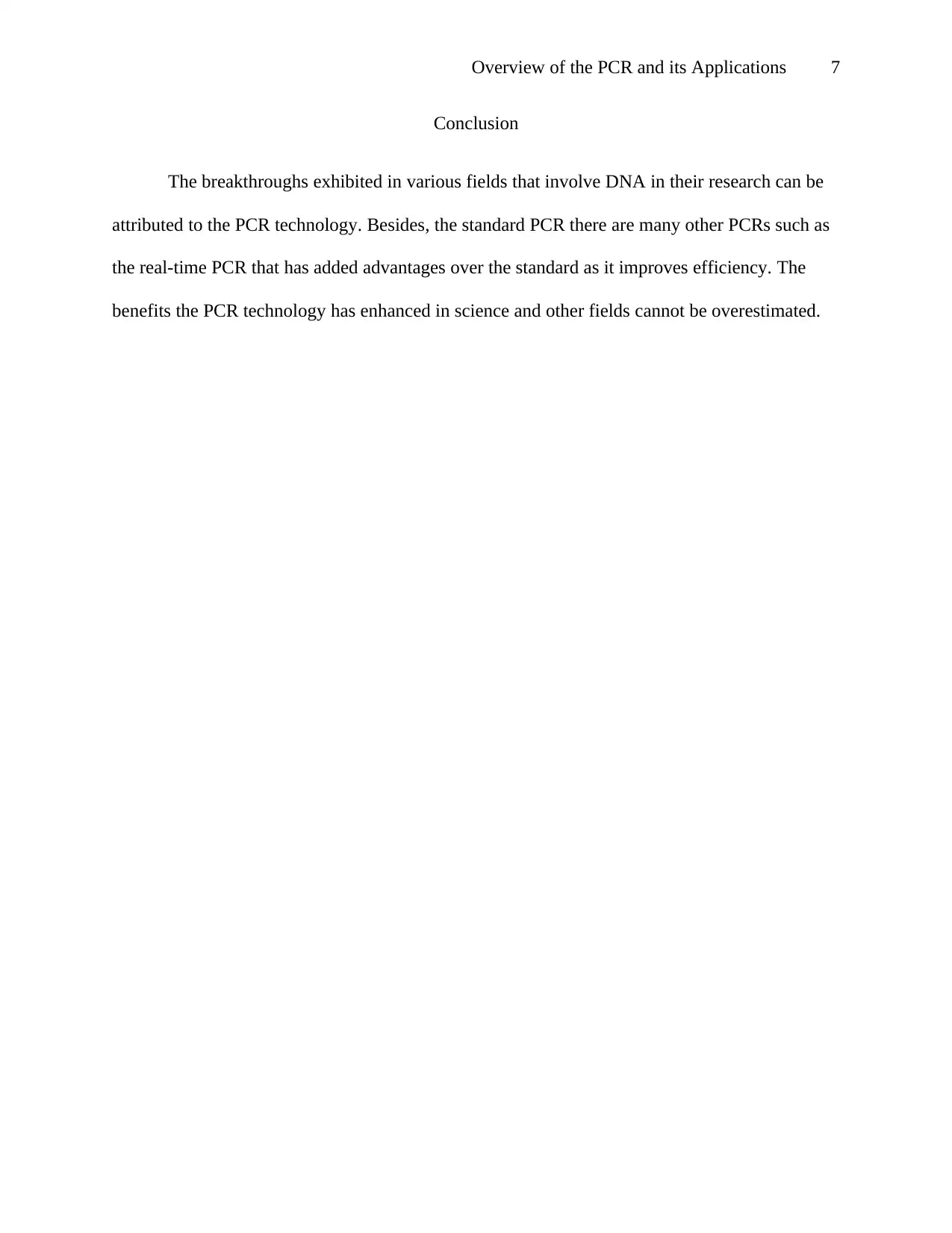
Overview of the PCR and its Applications 7
Conclusion
The breakthroughs exhibited in various fields that involve DNA in their research can be
attributed to the PCR technology. Besides, the standard PCR there are many other PCRs such as
the real-time PCR that has added advantages over the standard as it improves efficiency. The
benefits the PCR technology has enhanced in science and other fields cannot be overestimated.
Conclusion
The breakthroughs exhibited in various fields that involve DNA in their research can be
attributed to the PCR technology. Besides, the standard PCR there are many other PCRs such as
the real-time PCR that has added advantages over the standard as it improves efficiency. The
benefits the PCR technology has enhanced in science and other fields cannot be overestimated.
Paraphrase This Document
Need a fresh take? Get an instant paraphrase of this document with our AI Paraphraser
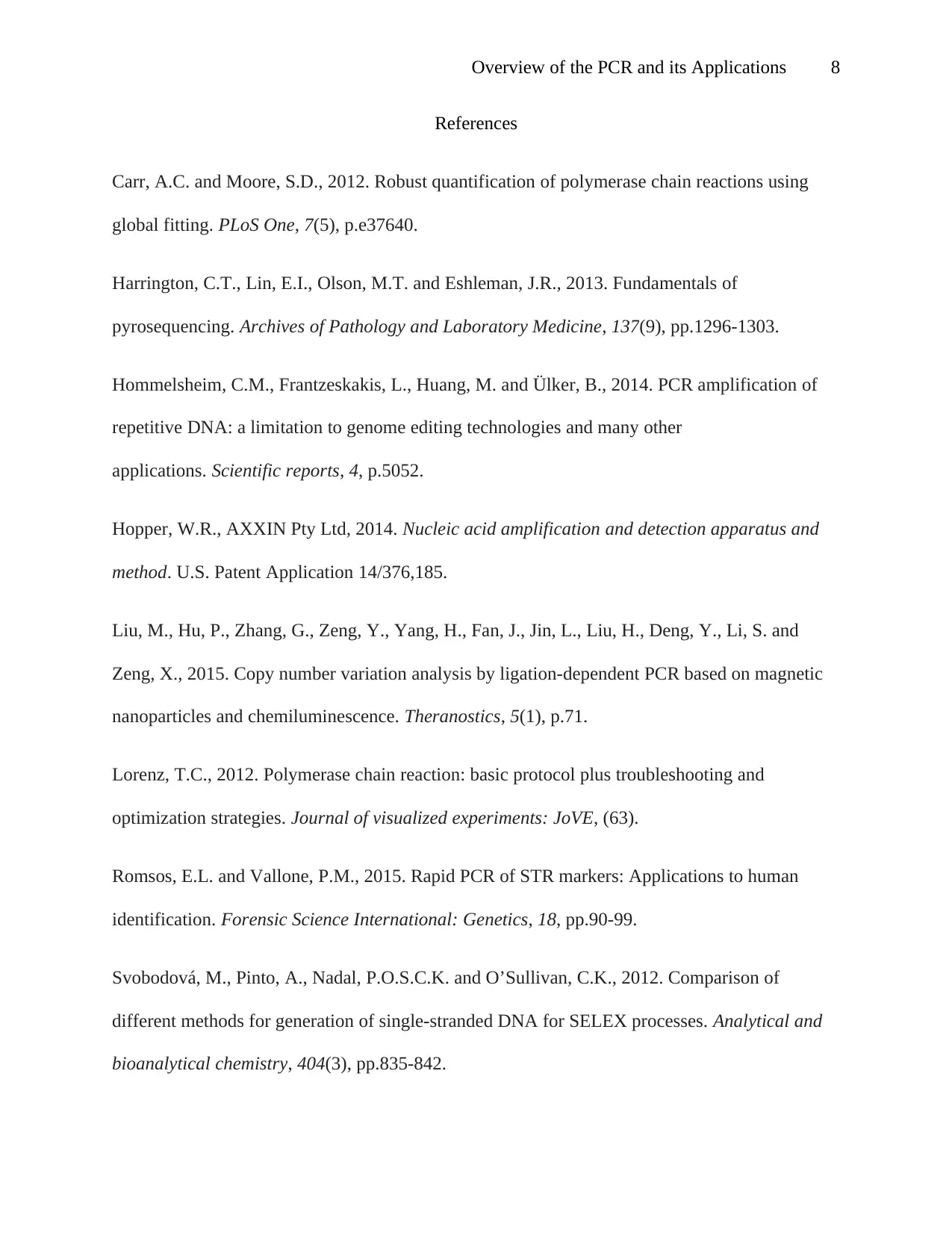
Overview of the PCR and its Applications 8
References
Carr, A.C. and Moore, S.D., 2012. Robust quantification of polymerase chain reactions using
global fitting. PLoS One, 7(5), p.e37640.
Harrington, C.T., Lin, E.I., Olson, M.T. and Eshleman, J.R., 2013. Fundamentals of
pyrosequencing. Archives of Pathology and Laboratory Medicine, 137(9), pp.1296-1303.
Hommelsheim, C.M., Frantzeskakis, L., Huang, M. and Ülker, B., 2014. PCR amplification of
repetitive DNA: a limitation to genome editing technologies and many other
applications. Scientific reports, 4, p.5052.
Hopper, W.R., AXXIN Pty Ltd, 2014. Nucleic acid amplification and detection apparatus and
method. U.S. Patent Application 14/376,185.
Liu, M., Hu, P., Zhang, G., Zeng, Y., Yang, H., Fan, J., Jin, L., Liu, H., Deng, Y., Li, S. and
Zeng, X., 2015. Copy number variation analysis by ligation-dependent PCR based on magnetic
nanoparticles and chemiluminescence. Theranostics, 5(1), p.71.
Lorenz, T.C., 2012. Polymerase chain reaction: basic protocol plus troubleshooting and
optimization strategies. Journal of visualized experiments: JoVE, (63).
Romsos, E.L. and Vallone, P.M., 2015. Rapid PCR of STR markers: Applications to human
identification. Forensic Science International: Genetics, 18, pp.90-99.
Svobodová, M., Pinto, A., Nadal, P.O.S.C.K. and O’Sullivan, C.K., 2012. Comparison of
different methods for generation of single-stranded DNA for SELEX processes. Analytical and
bioanalytical chemistry, 404(3), pp.835-842.
References
Carr, A.C. and Moore, S.D., 2012. Robust quantification of polymerase chain reactions using
global fitting. PLoS One, 7(5), p.e37640.
Harrington, C.T., Lin, E.I., Olson, M.T. and Eshleman, J.R., 2013. Fundamentals of
pyrosequencing. Archives of Pathology and Laboratory Medicine, 137(9), pp.1296-1303.
Hommelsheim, C.M., Frantzeskakis, L., Huang, M. and Ülker, B., 2014. PCR amplification of
repetitive DNA: a limitation to genome editing technologies and many other
applications. Scientific reports, 4, p.5052.
Hopper, W.R., AXXIN Pty Ltd, 2014. Nucleic acid amplification and detection apparatus and
method. U.S. Patent Application 14/376,185.
Liu, M., Hu, P., Zhang, G., Zeng, Y., Yang, H., Fan, J., Jin, L., Liu, H., Deng, Y., Li, S. and
Zeng, X., 2015. Copy number variation analysis by ligation-dependent PCR based on magnetic
nanoparticles and chemiluminescence. Theranostics, 5(1), p.71.
Lorenz, T.C., 2012. Polymerase chain reaction: basic protocol plus troubleshooting and
optimization strategies. Journal of visualized experiments: JoVE, (63).
Romsos, E.L. and Vallone, P.M., 2015. Rapid PCR of STR markers: Applications to human
identification. Forensic Science International: Genetics, 18, pp.90-99.
Svobodová, M., Pinto, A., Nadal, P.O.S.C.K. and O’Sullivan, C.K., 2012. Comparison of
different methods for generation of single-stranded DNA for SELEX processes. Analytical and
bioanalytical chemistry, 404(3), pp.835-842.
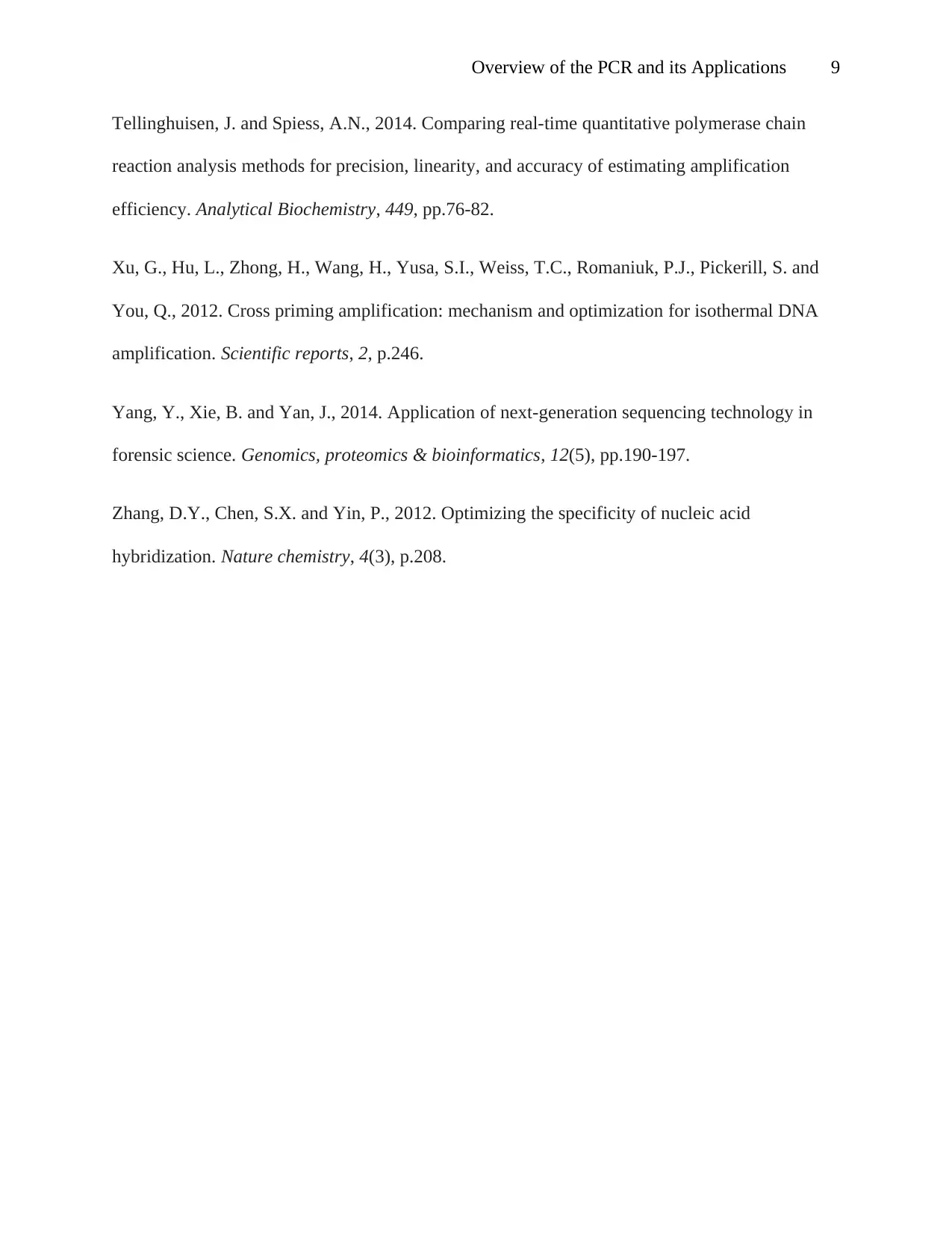
Overview of the PCR and its Applications 9
Tellinghuisen, J. and Spiess, A.N., 2014. Comparing real-time quantitative polymerase chain
reaction analysis methods for precision, linearity, and accuracy of estimating amplification
efficiency. Analytical Biochemistry, 449, pp.76-82.
Xu, G., Hu, L., Zhong, H., Wang, H., Yusa, S.I., Weiss, T.C., Romaniuk, P.J., Pickerill, S. and
You, Q., 2012. Cross priming amplification: mechanism and optimization for isothermal DNA
amplification. Scientific reports, 2, p.246.
Yang, Y., Xie, B. and Yan, J., 2014. Application of next-generation sequencing technology in
forensic science. Genomics, proteomics & bioinformatics, 12(5), pp.190-197.
Zhang, D.Y., Chen, S.X. and Yin, P., 2012. Optimizing the specificity of nucleic acid
hybridization. Nature chemistry, 4(3), p.208.
Tellinghuisen, J. and Spiess, A.N., 2014. Comparing real-time quantitative polymerase chain
reaction analysis methods for precision, linearity, and accuracy of estimating amplification
efficiency. Analytical Biochemistry, 449, pp.76-82.
Xu, G., Hu, L., Zhong, H., Wang, H., Yusa, S.I., Weiss, T.C., Romaniuk, P.J., Pickerill, S. and
You, Q., 2012. Cross priming amplification: mechanism and optimization for isothermal DNA
amplification. Scientific reports, 2, p.246.
Yang, Y., Xie, B. and Yan, J., 2014. Application of next-generation sequencing technology in
forensic science. Genomics, proteomics & bioinformatics, 12(5), pp.190-197.
Zhang, D.Y., Chen, S.X. and Yin, P., 2012. Optimizing the specificity of nucleic acid
hybridization. Nature chemistry, 4(3), p.208.
⊘ This is a preview!⊘
Do you want full access?
Subscribe today to unlock all pages.

Trusted by 1+ million students worldwide
1 out of 9
Related Documents
Your All-in-One AI-Powered Toolkit for Academic Success.
+13062052269
info@desklib.com
Available 24*7 on WhatsApp / Email
![[object Object]](/_next/static/media/star-bottom.7253800d.svg)
Unlock your academic potential
Copyright © 2020–2025 A2Z Services. All Rights Reserved. Developed and managed by ZUCOL.





